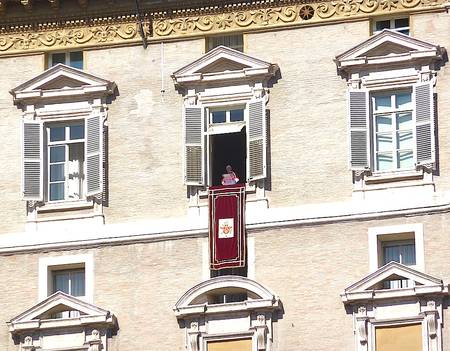It didn’t take long. A mere twenty-fours hours after Pope Benedict XVI announced his abdication, portents were being seen in the skies above the Vatican. Jupiter, the great god of the Romans, began rattling his thunderbolts and lightning was recorded striking the cupola of St Peter’s—twice. This is the kind of thing that happened on the eve of Caesar’s murder. “Never till to-night, never till now,” says a trembling Casca, “did I go through a tempest dropping fire. Either there is a civil strife in heaven, or else the world, too saucy with the gods, incenses them to send destruction.” Is that what heaven is doing? Or is it a seal of approval? After an eight-year pontificate, Jospeh Ratzinger is volunatrily vacating the Throne of St Peter. It is not an unprecedented step, but it is a controversial one. It is something that is not “done”. But Benedict XVI has never been afraid of controversy. While he lacks the charisma of his predecessor John Paul II and while he never inspired such fervent devotion in people’s hearts, he has been, in his thoughtful, mild-mannered way, revolutionary.

Pope Benedict is eighty-five. Before him lie who knows how many years of increasing frailty. It takes a vigorous and resilient man to hold the Christian world together. His decision to abdicate was taken, he says, “for the good of the Church”. The same was said in 1406, on the election of Gregory XII, who was raised to the pontificate purely on the understanding that he would resign, “for the good of the Church”, in order to heal the Great Western Schism. He did resign (though not as easily as all that; he was a wily old Venetian) in 1415. And the Schism did eventually heal. But what was this Schism, and how could a papal resignation heal it?
For most of the 14th century, the popes had abandoned Rome for Avignon in the south of France. This so-called “Babylonian captivity”, when the popes were “exiled” from their homeland, began when Pope Clement V (a Frenchman) was persuaded (by the French king) to set up his court in France. Political disturbances in Italy made this seem a good idea to Clement, and in 1309 he decamped to the peaceful banks of the Rhone. Horrified Italians—notably the poet Petrarch and St Catherine of Siena—begged for the papacy’s return, but it was not until 1377 that Gregory XI (also a Frenchman) re-established papal government in the Eternal City. (Since this Gregory, incidentally, there has never been another French pope—but who knows what may happen next month; the Archbishop of Paris is a current contender.) But though the popes came back to Rome, all was not healed. Strife and confusion were to dominate the next four decades, in the form of the Great Schism, which lasted from 1378 to 1417. This represented a complete rupture of ecclesiastical unity. Rival claimants to the papal throne were simultaneously nominated and crowned by competing factions of cardinals. For almost all of this period there were two or even three popes at once, each claiming to be the anointed successor to St Peter. The true popes found themselves locked in combat with rivals known as ‘antipopes’. Gregory XII was elected under the terms of a deal whereby both he and his rival, the antipope Benedict XIII, would simultaneously renounce their claims, allowing for a single successor to be appointed to replace both of them. For the good of the church. The plan worked—admittedly not without plenty of shenanigans—and eventually, in 1417, the Roman-born Oddone Colonna became Pope Martin V.
The Church hopes to have a new pope in place by Easter. But how do papal elections work?
A pope is elected by the cardinals, who form the “parish clergy” of Rome. The complicated rules for the conclave (from the Latin con clave, referring to a chamber that can be locked “with a key”) are designed to ensure that the election is not unnecessarily delayed, nor unduly hurried, and that it should be free from any kind of external pressure. After the death (or resignation) of the pope, all the cardinals are summoned to the conclave, which must be held in whatever city the pope dies, not necessarily Rome. The cardinals are housed in specially prepared apartments and before the conclave begins, a Mass of the Holy Spirit is celebrated, to invoke divine inspiration. Voting takes place twice a day, in the Sistine Chapel. The practice of burning the ballot papers, so as to indicate by the colour of the smoke whether or not a pope has been chosen, is probably a 20th-century innovation. A two-thirds majority is required, and it is usually obtained fairly quickly, though in 1799 the cardinals took three months to make up their minds. The winning candidate must be formally asked by the Cardinal Chamberlain whether he accepts the nomination. Sometimes he is very reluctant to do so: the infirm Leo XII, in 1823, pointed to his ulcerated legs and said, “Do not insist, you are electing a corpse.” Once he has accepted, and has chosen his regnal name (the last pope to use his real name was Marcellus II, in the mid-16th century), the new pontiff is robed and the Cardinal Chamberlain makes the announcement to the waiting crowds: Annuntio vobis gaudium magnum, habemus papam: I bring you tidings of great joy, we have a pope.
Pope Benedict XVI is to renounce his duties on February 28th. On the day preceding, Wednesday 27th, he will deliver his final audience to the public. Papal audiences are held every Wednesday morning, either in the purpose-built Vatican Audience Hall, or, if the weather is fine, in the open air. If you are going to be in Rome on that day, don’t miss it. It will be an emotional occasion.
(With extracts from Blue Guide Rome and Pilgrim’s Rome: A Blue Guide Travel Monograph, and featured on Stanfords blog.)






